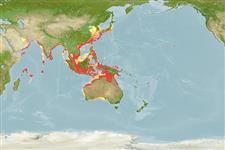>
Eupercaria/misc (Various families in series Eupercaria) >
Sciaenidae (Drums or croakers)
Etymology: Protonibea: Greek, protos = the first + see under Nibea.
More on author: Lacepède.
Issue
Type species of genus.
Environment: milieu / climate zone / rango de profundidad / distribution range
Ecología
marino; salobre demersal; rango de profundidad 5 - 100 m (Ref. 43239). Tropical; 40°N - 28°S, 47°E - 154°E
Indo-West Pacific: west coast of the Persian Gulf and along the coasts of India and Sri Lanka, north to Japan and south through the Philippines and Borneo to New Guinea and northern Australia.
Length at first maturity / Tamaño / Peso / Age
Madurez: Lm ?, range 85 - ? cm
Max length : 165.0 cm TL (female); common length : 100.0 cm SL macho / no sexado; (Ref. 9772); peso máximo publicado: 0.00 g; edad máxima reportada: 8 años (Ref. 72458)
Espinas dorsales (total) : 10 - 11; Radios blandos dorsales (total) : 22 - 25; Espinas anales: 2; Radios blandos anales: 7. 7-8 gill rakers on the lower limb of the first arch.
Body shape (shape guide): fusiform / normal.
Found in coastal waters over muddy bottoms, off the sea-bed. Ascend tidal rivers and estuaries (Ref. 9772). Feed mainly on crustaceans and small fishes. Also caught with bottom trawls (Ref. 9772). Sold fresh and dried salted (swim bladder) in markets. An important food fish. Minimum depth range based on occurrence (Ref. 118911).
Life cycle and mating behavior
Madurez | Reproducción | Puesta | Huevos | Fecundidad | Larva
Lal Mohan, R.S., 1984. Sciaenidae. In W. Fischer and G. Bianchi (eds.) FAO species identification sheets for fishery purposes. Western Indian Ocean (Fishing Area 51). Vol. 4. FAO, Rome. pag. var. (Ref. 3490)
IUCN Red List Status (Ref. 130435: Version 2025-1)
Threat to humans
Harmless
Human uses
Pesquerías: escaso valor comercial; Acuicultura: comercial
Herramientas
Special reports
Download XML
Fuentes de Internet
Estimates based on models
Preferred temperature (Referencia
123201): 24.6 - 29.1, mean 28.2 °C (based on 1838 cells).
Phylogenetic diversity index (Referencia
82804): PD
50 = 1.0000 [Uniqueness, from 0.5 = low to 2.0 = high].
Bayesian length-weight: a=0.00813 (0.00538 - 0.01228), b=3.07 (2.95 - 3.19), in cm total length, based on LWR estimates for this species & (Sub)family-body (Ref.
93245).
Nivel trófico (Referencia
69278): 3.5 ±0.6 se; based on diet studies.
Resiliencia (Referencia
120179): Medio, población duplicada en un tiempo mínimo de 1.4-4.4 años (K=0.29-0.52; tmax=8).
Fishing Vulnerability (Ref.
59153): Moderate vulnerability (45 of 100).
🛈
Nutrients (Ref.
124155): Calcium = 40.5 [14.2, 156.2] mg/100g; Iron = 0.578 [0.238, 1.642] mg/100g; Protein = 19.1 [17.3, 21.0] %; Omega3 = 0.206 [0.112, 0.346] g/100g; Selenium = 84.9 [44.5, 168.2] μg/100g; VitaminA = 9.38 [2.40, 34.23] μg/100g; Zinc = 0.722 [0.405, 1.471] mg/100g (wet weight); based on
nutrient studies.
